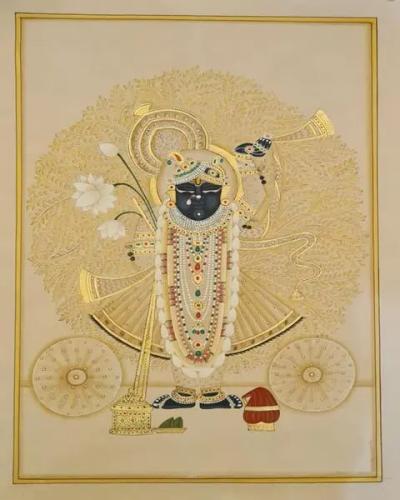The Rich Tapestry of Indian Artwork: A Journey Through Culture and Creativity

India, a land of diverse cultures, traditions, and heritage, has long been a cradle of artistic expression. The canvas of Indian art is as vast and varied as the subcontinent itself, spanning centuries of history and encompassing a multitude of forms, styles, and techniques. In this blog, we embark on a captivating journey through the world of Indian artwork, exploring its rich history, its vibrant tapestry of styles, and its enduring influence on global art and culture.
Chapter 1: The Roots of Indian Art
Indian art finds its roots deep in the annals of history, dating back to the Indus Valley Civilization, one of the world's oldest urban centers. The excavations at sites like Mohenjo-Daro and Harappa reveal intricate pottery, seals, and sculptures, showcasing the creativity and craftsmanship of ancient Indian inhabitants.
Religious and Mythological Influence: Hinduism, Buddhism, Jainism, and later, Islam, played significant roles in shaping Indian art. Temples, stupas, and mosques became the canvas for intricate carvings, frescoes, and sculptures that depicted gods, goddesses, and spiritual narratives.
Chapter 2: The Pinnacle of Indian Artistry: Temples and Sculptures
Khajuraho Temples: The temples of Khajuraho, a UNESCO World Heritage site, are celebrated for their exquisite erotic sculptures and intricate carvings. These temples, built between 950 and 1050 CE, exemplify the artistic mastery of that era.
Ajanta and Ellora Caves: The rock-cut cave temples at Ajanta and Ellora showcase the evolution of Indian art from the 2nd century BCE to the 6th century CE. These caves are adorned with stunning murals, sculptures, and architectural marvels that provide insights into India's cultural and religious history.
Chapter 3: The Age of Miniatures: Indian Painting
Miniature Paintings: The Mughal Empire ushered in a golden age of miniature painting in India. These intricate artworks, characterized by fine detailing and vivid colors, captured various facets of life, including court scenes, flora and fauna, and religious stories.
Rajput and Pahari Schools: The Rajput and Pahari schools of painting flourished in the northern regions of India. These schools produced vibrant and emotive miniature paintings, often depicting themes of love, devotion, and nature.
Chapter 4: The Vibrancy of Indian Textiles
Silk and Cotton: India is renowned for its textile craftsmanship. The country's rich tradition of silk and cotton weaving has produced exquisite fabrics, such as Banarasi silk, Kanchipuram silk, and Chanderi cotton, each reflecting regional aesthetics.
Block Printing and Embroidery: Techniques like block printing and embroidery have been passed down through generations. The intricate patterns and vibrant colors of Indian textiles have found global appreciation.
Chapter 5: Modern Indian Art: Fusion of Tradition and Innovation
The Bengal School: The Bengal School of Art, led by luminaries like Abanindranath Tagore and Nandalal Bose, sought to break away from Western influences and revive traditional Indian art forms. They played a pivotal role in the renaissance of Indian art in the early 20th century.
Progressive Artists' Group: In post-independence India, the Progressive Artists' Group, including luminaries like M.F. Husain, F.N. Souza, and S.H. Raza, ushered in a modernist movement, blending Indian themes with Western techniques. Their works are celebrated globally.
Chapter 6: Contemporary Indian Art: A Global Presence
Contemporary Artists: Contemporary Indian artists have gained international recognition for their innovative and thought-provoking works. Names like Subodh Gupta, Bharti Kher, and Anish Kapoor have established themselves as influential figures in the global art scene.
Chapter 7: The Global Impact of Indian Art
Influence on Western Art: Indian art has significantly influenced Western art movements. Artists like Vincent van Gogh and Gustav Klimt were inspired by Indian art, incorporating elements of Indian aesthetics into their works.
The Art Market: Indian art has also made its mark in the global art market. Auction houses regularly feature Indian artworks, with some pieces fetching record-breaking prices.
Chapter 8: Preserving Indian Art Heritage
Conservation Efforts: India has made concerted efforts to preserve its art heritage. Initiatives include the restoration of historical sites, the establishment of museums, and the documentation of traditional art forms.
Promotion of Art Education: Art education in India is gaining momentum, with institutions like the National Institute of Design (NID) and the National Academy of Fine Arts (NAFA) nurturing young talents and promoting traditional and contemporary art forms.
Chapter 9: The Future of Indian Art
Global Collaboration: Indian artists are increasingly collaborating with international artists and institutions, fostering cross-cultural exchanges and pushing the boundaries of creativity.
Digital Art and New Media: The digital age has opened up new avenues for Indian artists to experiment with digital art, interactive installations, and virtual reality, expanding the horizons of artistic expression.
Conclusion: A Kaleidoscope of Creativity
Indian artwork is a kaleidoscope of creativity, a testament to the nation's rich cultural tapestry and artistic heritage. From the exquisite sculptures of ancient temples to the vibrant canvases of contemporary artists, India's artistic journey is an ever-evolving narrative of innovation and tradition.
As Indian art continues to capture the imagination of the world, it stands as a shining example of the enduring power of creativity to transcend time and borders. It is a celebration of diversity, spirituality, and the boundless human capacity to express emotions, stories, and visions through the universal language of art.
So, whether you find yourself captivated by the intricate carvings of a temple in Khajuraho, the delicate brushstrokes of a Mughal miniature painting, or the bold experimentation of a contemporary Indian artist, remember that Indian artwork is an invitation to explore the depths of human imagination and the infinite hues of the human experience. It is a journey that promises to inspire, enlighten, and leave an indelible mark on your soul.
Post Your Ad Here
Comments